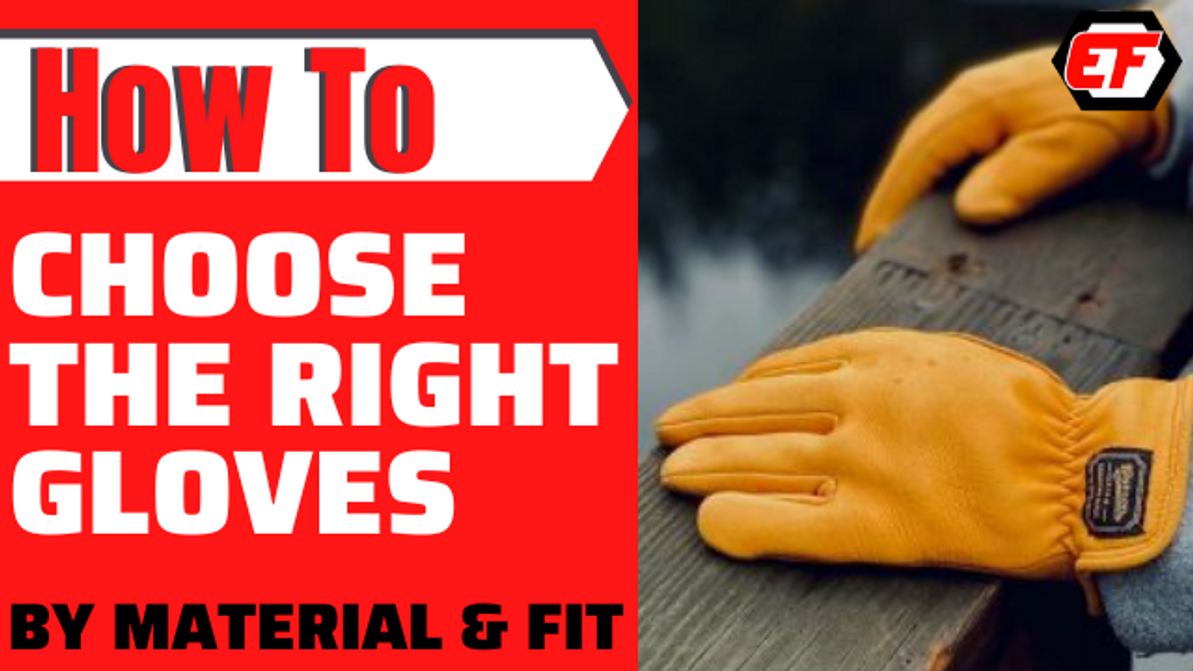
How To Choose Safety Gloves
At Edmonton Fasteners, we know that healthy hands are essential for any job. While we’re not a skincare brand, we offer a wide range of products designed to protect your hands from the wear and tear of daily work. One of the simplest and most effective tools for this is a good pair of safety gloves. Whether you're working in construction, manufacturing, or even at home, choosing the right gloves can make all the difference.
We carry many trusted brands like Ansell, Bob Dale, Mechanix, Impacto, Milwaukee, Rigid, and Superior. In this guide, we’ll walk you through the different materials used in safety gloves, their specific uses, and how to choose the best one for your needs. Whether you call them work gloves or safety gloves, they’re an essential part of keeping your hands safe while you work.
Material
When it comes to safety gloves, the material plays a huge role in determining their effectiveness and comfort. Here’s a breakdown of some of the most common materials and their applications:
Leather
Leather gloves are made from cowhide, pigskin, or goat skin and are known for their breathability, softness, and durability. Cowhide is the most common type and offers excellent protection against abrasions. These gloves are ideal for jobs involving woodworking, landscaping, and outdoor work.
Canvas
Canvas gloves are thick, durable, and resistant to cuts and blisters. They are often used in heavy-duty environments where hand protection is crucial. Some canvas gloves are also water-resistant, making them suitable for wet conditions.
Latex
Latex gloves are widely used across industries such as food service, healthcare, automotive, and cleaning. With the rise of health awareness, more people are using latex gloves for everyday tasks like grocery shopping. Latex provides excellent protection against bacteria, viruses, and body fluids. However, it should be avoided by those with latex allergies.
Nitrile
Nitrile gloves are similar in appearance to latex but are made from synthetic rubber. They are stronger than latex, especially when it comes to puncture resistance, and offer better chemical and oil resistance. They are a popular choice in industrial and medical settings.
Polyurethane
Polyurethane gloves provide excellent grip and protection against oils, chemicals, and abrasions. They are often coated on fabric gloves to enhance durability and flexibility. These gloves are comfortable and ideal for tasks requiring precision and dexterity.
PVC
PVC gloves are made from polyvinyl chloride and are known for their strong grip, even in wet or oily conditions. They are commonly used in industrial and commercial settings where slip resistance is important.
Cuffs
The cuff of a glove may seem small, but it plays a vital role in protecting your hands. Different cuff styles offer varying levels of protection and comfort. Here are some of the most common types:
Knit Wrist Cuff
This snug-fitting cuff is perfect for preventing dirt and debris from entering the glove. It’s commonly found on leather, cotton, and dipped gloves, offering a secure fit without sacrificing comfort.
Ranch Cuff or Safety Cuff
These cuffs are loose and breathable, allowing air to circulate and keep your hands cool. They are great for long hours of use and can be easily removed when needed.
Slip-On Cuff
Designed for easy donning and doffing, the slip-on cuff has no seam between the glove and the cuff, making it ideal for jobs that require frequent removal of gloves.
Long Cuff (Gauntlet)
The gauntlet cuff is longer and looser, offering extra protection for the wrist and forearm. While it provides more coverage, it may be less secure and easier to slip off compared to other styles.
Choosing the right gloves depends on your specific needs, whether it's protection from chemicals, cuts, or extreme weather. Take the time to understand the materials and features that matter most to your job. If you have any questions, feel free to reach out to our team at Edmonton Fasteners.
Follow us on Instagram and subscribe to our newsletter for more tips and updates. Have a GLOVELY day!
Tert-Butyl peroxybenzoate (TBPB) a chemical compound from the group of peresters. It is often used as a radical initiator in polymerization reactions, such as the production of LDPE from ethylene, and for crosslinking, such as for unsaturated polyester resins.
TBPB is a low volatility ,high purity,liquid, aromatic peroxuester.it is effective as medium of a broad spectrum of monomers e.g .styrene.ethylenn,acrylics.it is also used to cure (copolymerzation) unsaturated resins .
TBPB is a clear light yellow liquid, which is little soluble in water but well in many organic solvents such as ethanol or phthalate.
As peroxo compound, TBPB contains about 8.16 wt% of active oxygen and has a self accelerating decomposition temperature (SADT) of about 60 °C. The SADT is the lowest temperature at which self-accelerating decomposition in the transport packaging can occur within a week, and which should not be exceeded while storage or transportation.[2] TBPB should therefore be stored between minimum 10 °C (below solidification) and maximum 50 °C. Dilution with a high-boiling solvent increases the SADT. The half-life of TBPB, in which 50% of the peroxy ester is decomposed, is 10 hours at 104 °C, one hour at 124 °C and one minute at 165 °C. Amines, metal ions, strong acids and bases, as well as strong reducing and oxidizing agents accelerate the decomposition of TBPB even in low concentrations.[ However, TBPB is one of the safest peresters or organic peroxides in handling. The main decomposition products of tert-butyl peroxybenzoate are carbon dioxide, acetone, methane, tert-butanol, benzoic acid and benzene.
98%Tert-Butyl Peroxy Benzoate,98%Tert-Butyl Peroxy Benzoate Compound,98%Tert Butyl Peroxy Benzoate,98%Tert-Butyl Peroxy
Jiangxi Zhewei Material Technology Co.,Ltd , https://www.jxzwchem.com